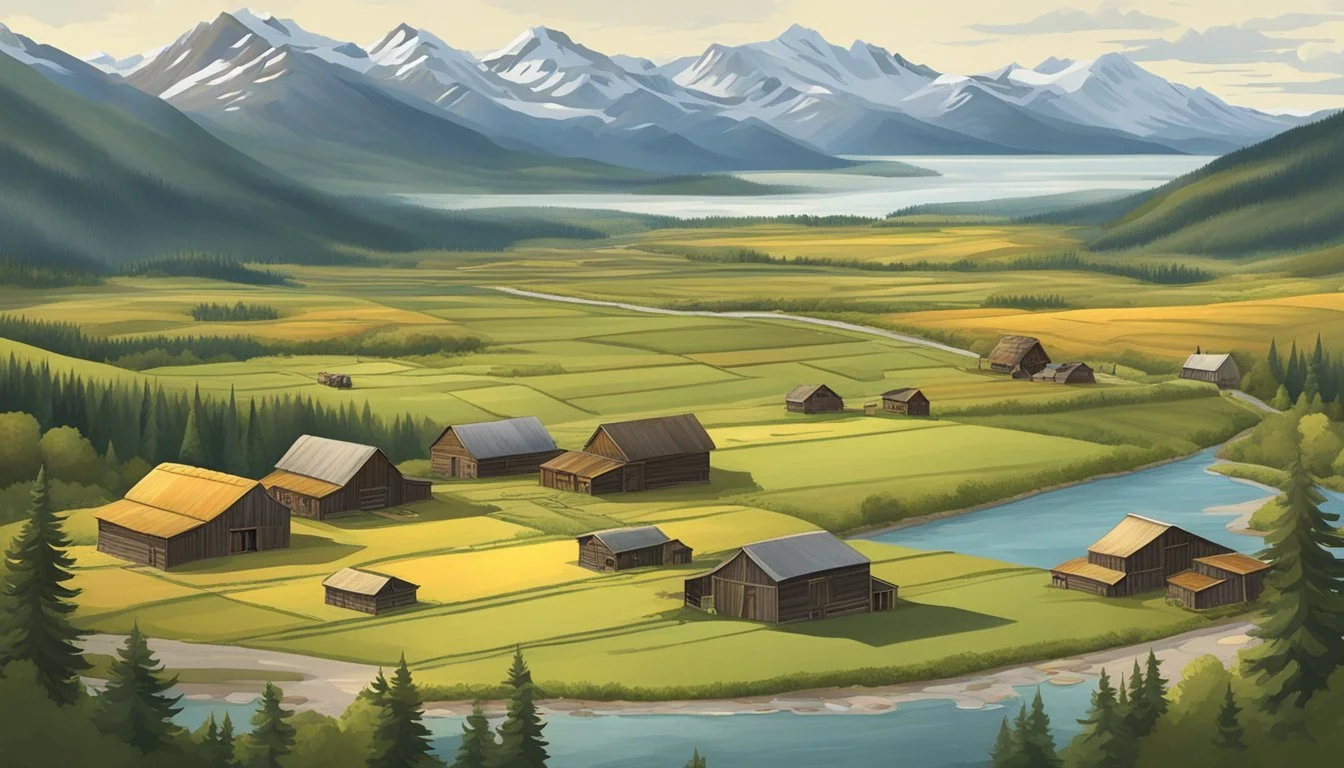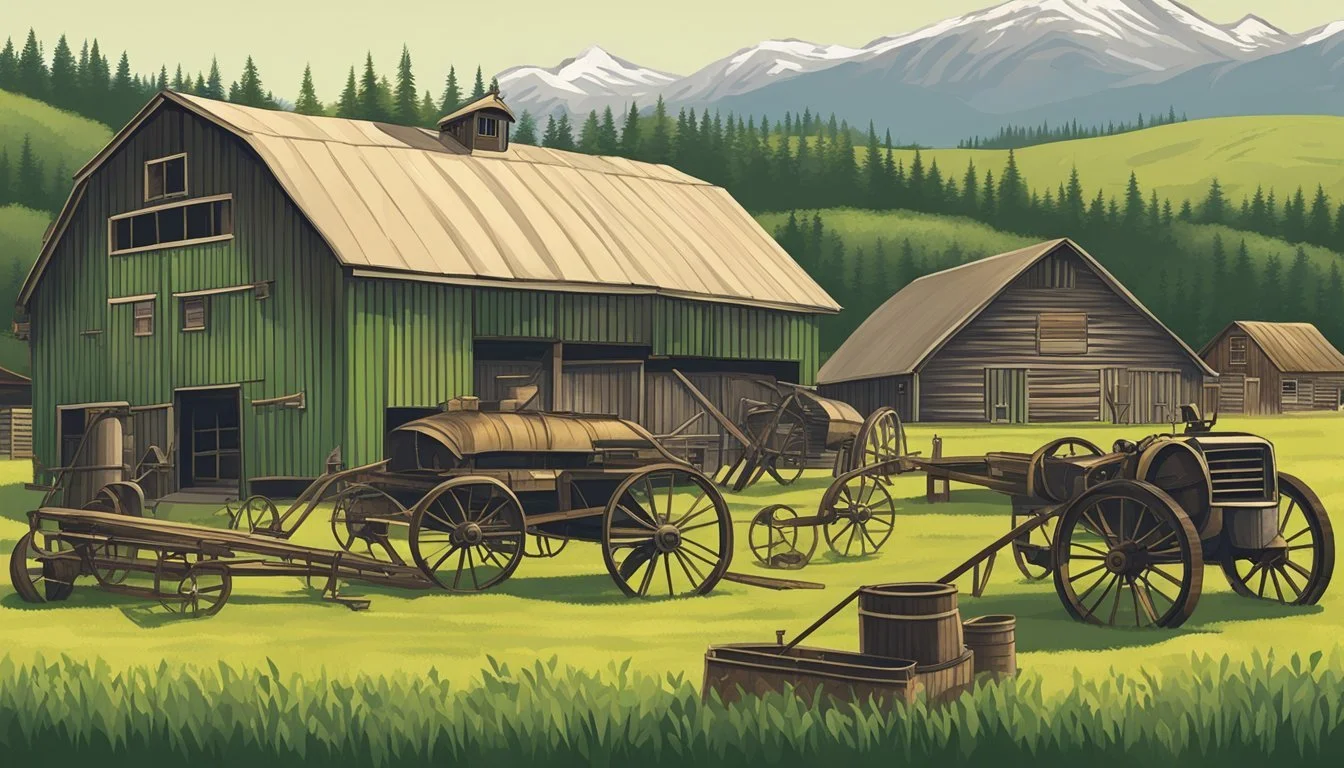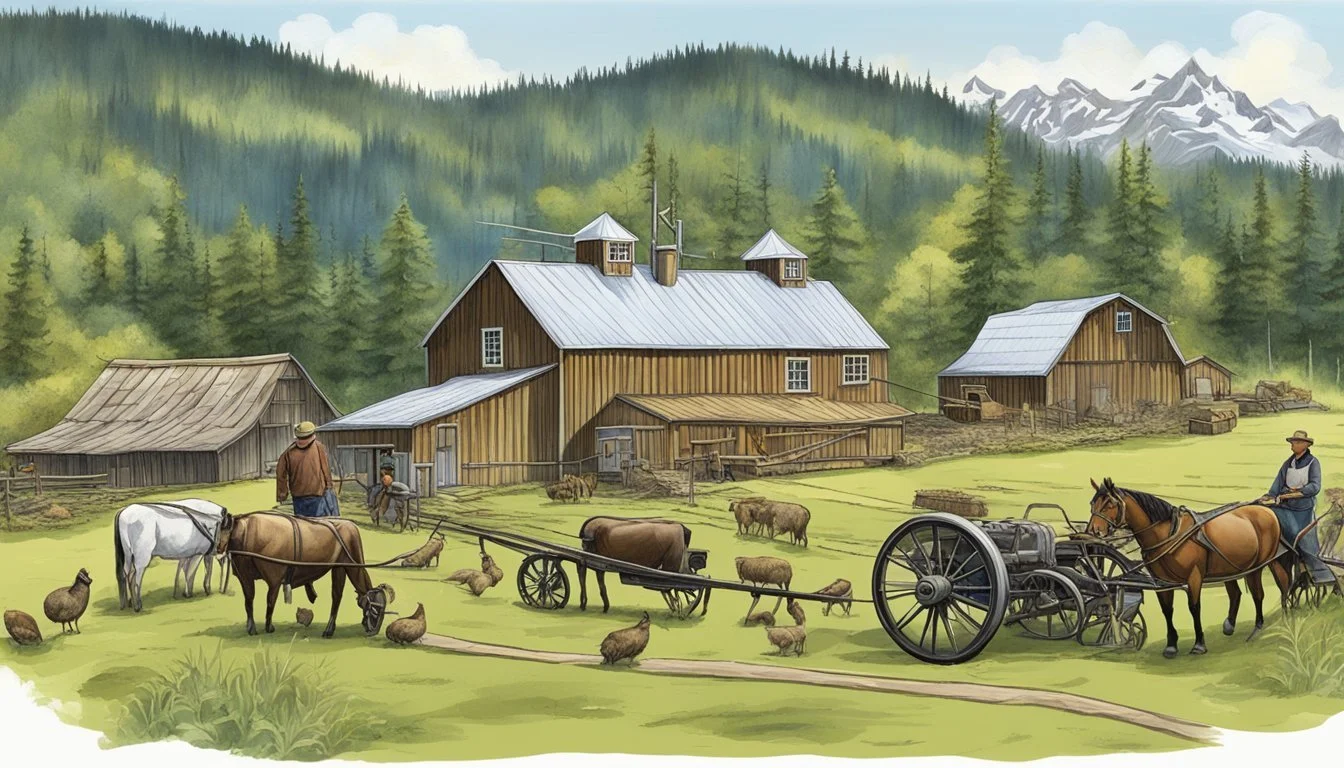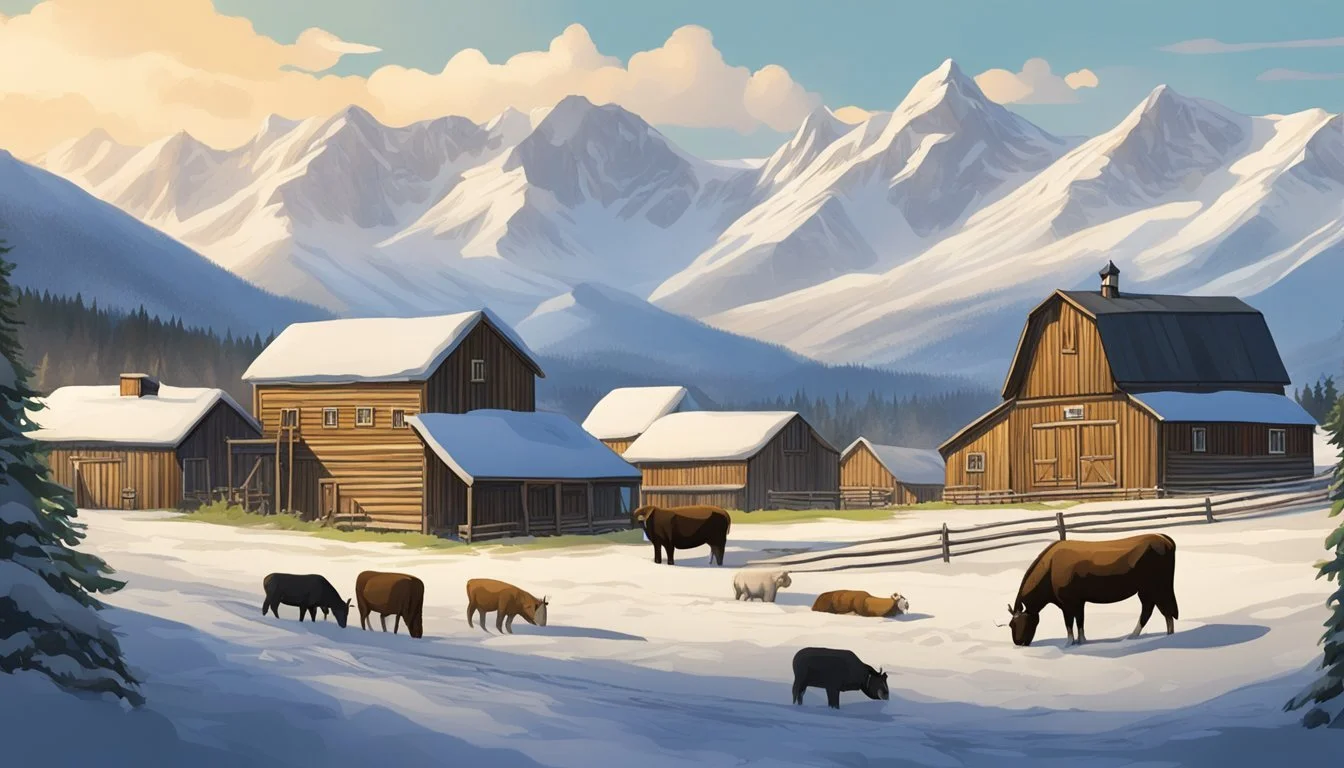Historical Farms and Agricultural Museums in Alaska
A Guide to the Last Frontier's Agrarian Heritage
Alaska's rich soil and unique climate have played a pivotal role in its agricultural history—a narrative captured and preserved within the state's historical farms and agricultural museums. These living testaments to the past allow visitors to explore the evolution of farming in the region, from the native practices long before statehood to the New Deal resettlement project that transformed the landscape. The Matanuska Colony, for example, stands as a significant chapter in Alaska's farm history, with numerous original structures still dotting the lush terrain of Palmer, allowing for an immersive educational experience.
Agricultural museums in Alaska not only chronicle the history of farming practices but also celebrate the ingenuity required to cultivate the land under the Midnight Sun. Interactive exhibits and historical re-enactments provide insights into the daily lives of Alaska's early farmers. Visitors can examine the colossal vegetables that continue to grow in the Mat-Su Valley, a testament to the area's farming heritage and a popular feature at the Alaska State Fair.
As the northernmost state with a surprising diversity of agricultural activities, Alaska offers a unique perspective on American farming history. The preservation efforts by these museums and historical farms also contribute to an understanding of sustainable practices essential for farming in challenging environments. Whether through a scenic drive along Farm Loop Road or leisure activities within historical colony farm settings, the connection between the land and its people is vividly articulated in these cultural sites.
Historical Context of Agriculture in Alaska
Agriculture in Alaska has a rich, dynamic history marked by adaptation and innovation. This history spans from the subsistence practices of indigenous peoples to the contemporary efforts in modern farming.
Pre-Colonial and Russian Periods
Before colonization, the indigenous peoples of Alaska maintained traditional subsistence practices, adapted to the region's harsh climate. The introduction of agriculture began with Russian settlers in the 18th century, who initiated the cultivation of crops like potatoes and cabbage in the more temperate climates of the Aleutian Islands and the Kodiak archipelago.
American Acquisition and Early 20th Century
After the United States purchased Alaska from Russia in 1867, the focus on agriculture intensified. The early 20th century saw the establishment of experimental farms, such as those overseen by Charles C. Georgeson, to determine the viability of agriculture in Alaska's unique environment.
World War II Impact on Alaskan Farming
World War II brought significant changes to Alaskan agriculture, with the need for self-sufficiency leading to the increased development of farming within the territory. This period saw efforts to expand agricultural output, not only to support the local population but also to supply the military stationed in the region.
Statehood and Modern Development
After Alaska attained statehood in 1959, modern agricultural development accelerated. Large-scale farming occurred, including the notable 1935 Matanuska Colony project, which brought families from the Midwest to establish a farming community. Present-day Alaska continues to explore agricultural potential, balancing the challenges of the northern environment with advancements in technology and cultivation techniques.
Key Historical Farms in Alaska
Alaska's history is richly infused with agricultural endeavors, from the impactful Matanuska Colony project that revitalized farming during the Great Depression to the self-sufficient farms of the Gold Rush era. These historic farms not only showcase Alaska's ability to overcome challenges but also its diverse approach to agriculture, including dairy farms and livestock operations akin to those in the 'Lower 48'.
Palmer and the Matanuska Colony
In the early 1930s, the Matanuska Colony was established near Palmer as part of a New Deal program to address the difficulties of the Great Depression. This project transformed Alaska's agricultural landscape by relocating over 200 families from the Midwest to farm the Alaskan land. The Colony House Museum stands today as a testament to the struggles and triumphs of these pioneering farmers. The area around Palmer continues to be a hub for Alaska-grown vegetables, famously producing record-breaking cabbages and other crops thanks to the extended daylight hours during the growing season.
Gold Rush Era Farms
The influx of people during the Alaska Gold Rush brought a need for locally-produced food to support the mining communities. Small-scale farms sprang up, providing sustenance for miners and contributing to the development of a self-sustaining agricultural economy in a starkly beautiful environment historically viewed as inhospitable. These farms, integral to the survival of Gold Rush-era settlements, laid the groundwork for more systemic agricultural practices seen in Alaska today.
Historic Dairy Farms and Livestock
Dairy farming and livestock became prominent as Alaska sought to build a more stable and varied agricultural economy. Historic dairy farms like the Havemeister Dairy in Palmer have been producing milk since the early 20th century. Some of these historic operations still function today, providing a link to Alaska’s past and an ongoing contribution to its agriculture. These farms remind us of the innovation and resilience that is required to manage livestock and dairy operations in the unique Alaskan climate.
Agricultural Museums and Collections
Alaska's rich agricultural history is preserved and showcased in various museums and collections across the state. These institutions serve as valuable resources for understanding the development of farming and the unique agricultural practices in Alaska's past and present.
Alaska State Museum Exhibits
The Alaska State Museum in Juneau presents a broad array of exhibits that narrate the story of Alaska’s agricultural heritage. Among these, the displays focus on the state's farming history, including the transition from the use of traditional, indigenous techniques to modern agricultural practices. The museum’s collection offers insights into the evolution of farming tools, the introduction of new crops, and the impact of agriculture on Alaska's economy and culture.
Sheldon Jackson Museum and Its Collections
Situated in Sitka, the Sheldon Jackson Museum boasts an impressive collection of historical artifacts, many of which shed light on the agricultural practices of Native Alaskan communities. These collections help trace the region’s history from subsistence activities to more structured agricultural and farming efforts. The museum provides a unique perspective on local agricultural methods, emphasizing the adaptations made to thrive in Alaska's challenging environment.
Museum of Alaska Transportation and Industry
Matanuska-Susitna Valley's Museum of Alaska Transportation and Industry comprehensively exhibits Alaska's transportation, technology, and the role of agriculture in the state's development. The museum brilliantly captures the significant transition moments in Alaskan agriculture, such as the establishment of the Matanuska Colony, which dramatically reshaped the local farming landscape with its introduction of new farming techniques and technologies.
Cultural Heritage and Education
Alaska's historical farms and agricultural museums are integral in preserving the region's rich cultural heritage through various educational endeavors. They actively engage with the community by offerings hands-on living history experiences, comprehensive educational programs, and in-depth lectures and workshops tailored to enlighten visitors of all ages.
Living History and ALHFAM
Alaska's living history venues, such as colonial farms, establish a tangible connection with the past. The Association for Living History, Farm and Agricultural Museums (ALHFAM) serves as a pivotal resource, linking individuals to museums that exemplify agricultural and historical practices through interactive portrayals.
Educational Programs and Tours
Educational programs in these settings often include guided tours that provide insight into the historical significance and ongoing preservation efforts of these landmarks, ensuring the legacy of Alaska's agriculture remains accessible to future generations.
Lectures and Workshops
In addition to tours, many agricultural museums in Alaska offer lectures and workshops. These programs are designed to educate attendees on a variety of topics from historical farming techniques to the cultural impacts of agriculture in this region. Institutions such as Ketchikan Museums may also showcase specific events aimed at illuminating the local history and fostering community engagement.
Visitor Experience
In Alaska, visitors can engage with the state's agricultural history firsthand through interactive farm tours and museum visits. Admission fees are modest, and the sites often feature gift shops where guests can purchase mementos of their experiences.
Interactive Farm Tours
Visitors can engage with Alaska's farming heritage up close on interactive farm tours. For example, at Alaska Farm Tours, they can embark on a journey that starts at the Palmer Museum and includes hands-on experiences with native species and arctic plants. Tours are typically family-friendly and provide a rich narrative about the state's agricultural past and present practices.
Museum Hours of Operation and Admissions
Museums such as The Matanuska Colony have specific hours of operation. Most museums are open to the public during the summer season, with hours extending from 9 a.m. to 5 p.m. on weekdays, with some offering weekend hours. Admissions vary, but they tend to be affordable, often ranging from $5 to $15, with discounts for children and seniors.
Museum Hours Admission Fee The Matanuska Colony Mon - Fri 9 a.m. - 5 p.m. Adults $10, Children $5
Gift Shops and Memorabilia
After exploring the museums and farms, visitors have the option to stop by the gift shop to purchase memorabilia. Items often reflect the unique agricultural history of the region, ranging from locally made food products to handcrafted items. The Matanuska Colony's Visitor Center, for instance, is a place where guests can find educational materials and distinctive souvenirs to remember their journey through Alaska's farming legacy.
Community and Agricultural Organizations
In Alaska, community and agricultural organizations play a pivotal role in connecting individuals to the state's rich agricultural heritage and fostering a sustainable future for farming practices.
Alaska Farmers Union and Cooperative Extensions
The Alaska Farmers Union advocates for the interests of local farmers and promoters, aiming to strengthen the agricultural community within the state. They offer resources and support to both new and established farmers, ensuring that agricultural practices can thrive in Alaska's unique environment. Alongside this, Cooperative Extensions provide critical outreach by supplying educational programs and research-based knowledge. Specifically, they assist with issues related to agriculture, home economics, and natural resources.
The Importance of Local History Groups
Local history groups are integral to preserving Alaska's agricultural past. By maintaining records and sharing stories, they ensure that the legacy of pioneering farmers and agricultural communities is not forgotten. Groups such as the Association for Living History, Farm and Agricultural Museums contribute significantly by making the history of farming accessible and engaging to the public. They highlight how past farming methods inform current practices and help to cultivate a deeper understanding of Alaska’s agricultural impact.
Concluding Thoughts on Alaskan Agricultural History
Alaska's agricultural history is a testament to human resilience and innovation. Museums and historic farms across the state showcase the heritage of farming in a challenging environment. The Matanuska Colony, as a notable example, represents the determination of the 1930s settlers who transformed the Mat-Su Valley into what is now recognized as Alaska's agricultural heartland.
Key Highlights:
The Matanuska Colony: A pivotal New Deal project that put Alaska on the map for agriculture.
Agricultural Museums: They offer insights into the local methods and cropping systems adapted to Alaska's unique climate.
Cultural Influence: Indigenous practices and the historical adaptations by settlers depict a rich tapestry of agricultural knowledge.
Whether it is the historical farms that dot the vast landscape or the comprehensive collections found in agricultural museums, visitors can glean a deep understanding of the challenges faced and overcome by Alaskan farmers. One realizes that agriculture in Alaska is not merely about production but also about cultural identity and communal solidarity.
The work of agricultural pioneers and the ongoing efforts in the field are captured through interactive exhibits and preserved artifacts. These spaces serve as educational resources for both residents and visitors to appreciate the state's legacy in farming against the odds posed by its unique geography and climate.
Through engaging with Alaska's agricultural past, one gains a profound respect for the harmony between the land and its cultivators. The historical narrative is not only informative but also an inspiring reflection of a community's connection to the soil and their environment.
References and Further Reading
For those interested in the era of New Deal projects and the establishment of agricultural communities in Alaska, The Matanuska Colony is an indispensable resource. It details the inception of the Matanuska Colony as a federal government project to foster agriculture in Alaska. The history is well-documented on the webpage titled "The Matanuska Colony: The New Deal in Alaska" which offers insights into this unique chapter of Alaskan history.
Those curious about the agricultural prowess of Alaska and how giant vegetables grow under the midnight sun can refer to the detailed article from Atlas Obscura. This resource describes the Matanuska Valley farming community and includes historical photographs. The article, "The Farming Colony That Grew Under the Midnight Sun," narrates the journey of these families to their new home and the agricultural successes in the region.
Researchers exploring Alaska's fur farming industry during the 1920s would benefit from Sarah Isto's comprehensive examination. Her book "The Fur Farms of Alaska: Two Centuries of History and a Forgotten," available through Google Books, presents an in-depth look at the industry's establishment and ultimate decline, available here: "The Fur Farms of Alaska".
For a broader view of the state's rich history, enthusiasts should explore the list from More Than Just Parks, which describes various sites across Alaska with significant historical implications. This expert guide, titled "10 MUST-SEE Historic Sites In Alaska," includes areas of historical interest beyond agriculture, offering a more holistic understanding of Alaska's past.
Finally, National Geographic Education Blog provides a thought-provoking look at the modern state of farming in Alaska, discussing the logistical challenges and the importance of self-sufficiency. Readers can enhance their knowledge of the current agricultural climate by reading "Alaska: The Last Frontier of Farming."










